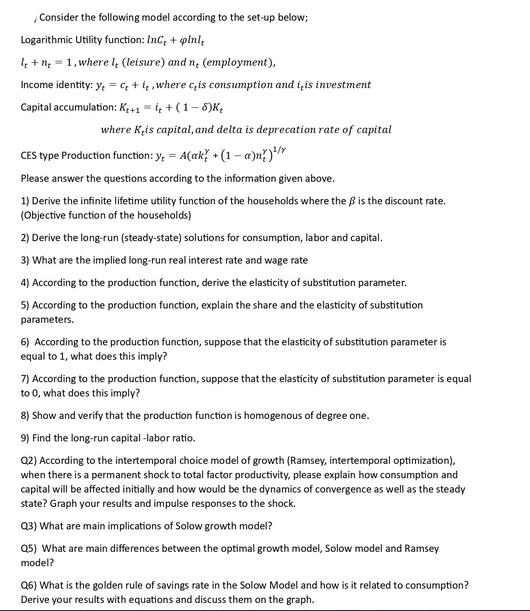Answered step by step
Verified Expert Solution
Question
1 Approved Answer
Consider the following model according to the set-up below; Logarithmic Utility function: InC, + plnl, le + ne = 1, where I (leisure) and

Consider the following model according to the set-up below; Logarithmic Utility function: InC, + plnl, le + ne = 1, where I (leisure) and n, (employment), Income identity: y = c + i,,where cis consumption and i,is investment Capital accumulation: K+1=1+(1-5)K where K,is capital, and delta is deprecation rate of capital CES type Production function: y = A(ak? +(1-a)n?)/ Please answer the questions according to the information given above. 1) Derive the infinite lifetime utility function of the households where the is the discount rate. (Objective function of the households) 2) Derive the long-run (steady-state) solutions for consumption, labor and capital. 3) What are the implied long-run real interest rate and wage rate 4) According to the production function, derive the elasticity of substitution parameter. 5) According to the production function, explain the share and the elasticity of substitution parameters. 6) According to the production function, suppose that the elasticity of substitution parameter is equal to 1, what does this imply? 7) According to the production function, suppose that the elasticity of substitution parameter is equal to 0, what does this imply? 8) Show and verify that the production function is homogenous of degree one. 9) Find the long-run capital-labor ratio. Q2) According to the intertemporal choice model of growth (Ramsey, intertemporal optimization), when there is a permanent shock to total factor productivity, please explain how consumption and capital will be affected initially and how would be the dynamics of convergence as well as the steady state? Graph your results and impulse responses to the shock. Q3) What are main implications of Solow growth model? Q5) What are main differences between the optimal growth model, Solow model and Ramsey model? Q6) What is the golden rule of savings rate in the Solow Model and how is it related to consumption? Derive your results with equations and discuss them on the graph.
Step by Step Solution
★★★★★
3.46 Rating (146 Votes )
There are 3 Steps involved in it
Step: 1
1 Derive the infinite lifetime utility function of the households where the is the discount rate Objective function of the households The infinite lifetime utility function of the households can be de...
Get Instant Access to Expert-Tailored Solutions
See step-by-step solutions with expert insights and AI powered tools for academic success
Step: 2

Step: 3

Ace Your Homework with AI
Get the answers you need in no time with our AI-driven, step-by-step assistance
Get Started


